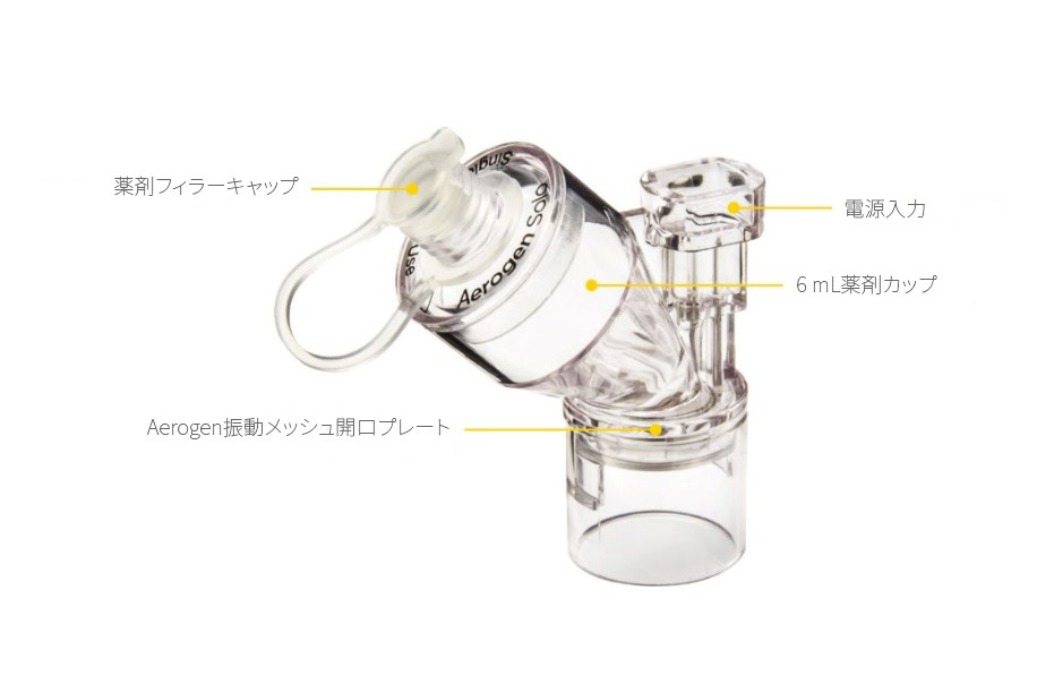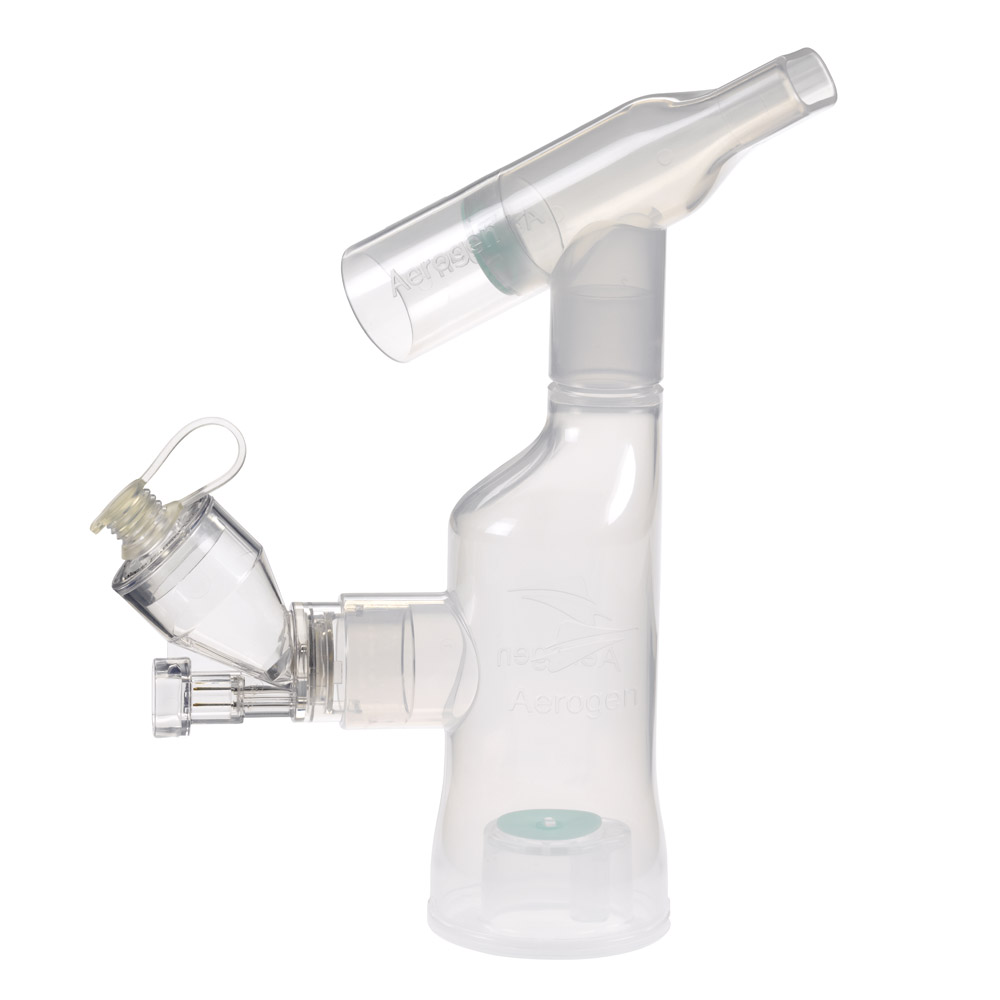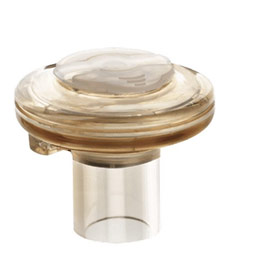急性期治療における吸入薬剤投与の世界的リーダー、Aerogen製 Aerogen Solo について†1
侵襲的人工呼吸(IMV)、呼吸サポート(NIV)等の非侵襲的人工呼吸、ハイフロー(HF)療法、及び自発呼吸(SV)等、あらゆる治療過程において、Aerogen Soloがどの様に患者さんへの吸入薬剤投与を支援するかについて。2
†75 か国を超える世界市場でビジネスを展開
- 迅速で容易なセットアップ2
- 静音設計2
- 単一患者使用2
- 最大28日間の間欠的使用または7日間の連続使用が可能2
- フローの追加不要2
- 薬剤再充填時に回路の開放が不要2
- 6 mL カップ2
- Y字状回路または加湿器に設置可能2


有効性
Aerogenは、様々な呼吸モダリティで、有効薬剤の投与をサポートします。3-8†
- ジェットネブライザーとの比較試験において、IMV、†3,4 NIV ‡5および HF6では、 Aerogenによる薬剤沈着 は約 4 倍、SV ‡7では約6倍を達成しました。
‡健常者を対象とした研究

患者ケア
Aerogenは、吸入薬剤に応じて、患者ケアを改善します。9-11
いくつかの呼吸モダリティを用い気管支拡張薬送達を比較した研究において、ジェットネブライザーとAerogen Soloを比較したところ、以下の結果が得られました。
- NIV を受けている患者さんの肺機能の改善†9
- HF 10では、同等の気管支拡張効果
- SV 患者において、入院率、救急部門滞在時間の中央値、症状コントロールに要した治療回数と時間が減少¶11
† COPDの急性増悪患者におけるベースラインから120分までのFEV 1 、FVC、息切れスコア、RR、およびPaCO 2の群間差
‡定義は、可逆性閉塞性肺疾患患者における FEV 1の相対的増加とした
§定義は、喘息増悪後に喘息スコアが軽度まで改善することとした
¶ Aerogen Ultra と併用した場合

ワークフロー
ワークフローを簡素化するAerogen
- Aerosol Soloは、閉鎖回路の吸入薬剤投与システム2で、IMVやNIVでの薬剤投与時に回路の開放が不要です。
- SV患者では、Aerogen Solo をHFと一体化した吸入薬剤投与、またAerogen Ultra と組み合わせた吸入薬剤投与が可能です2
- Aerogen Soloは、汎用ネブライザー用に使用承認を得ている医療用吸入医薬品を、エアロゾル化するためのデバイスです。2
- 1つのシステムでひとりの患者さんの呼吸療法全過程(IMV、NIV、HF、SV)2に対応し、継続的なケアを支援します。

お問い合わせ
世界中から、AerogenチームとAerogen代理店にコンタクトが可能です。ご質問へのお答え、オンラインデモンストレーション、受注を担当いたします。
Aerogen Solo
製品サポート
Aerogen Ultra with a face mask for EMS use: set-up guide
Aerogen Ultra with mouthpiece for EMS use: set-up guide
Aerogen Solo on a NIV single-limb circuit for EMS use: set-up guide
Aerogen Solo on the dry side of the humidifier: set-up guide
Aerogen Solo for adult nasal high-flow: set-up guide
Aerogen Solo for paediatric nasal high-flow: set-up guide
Aerogen Solo at the wye: set-up guide
Aerogen Continuous Nebulisation Tube: set-up guide
General
I have a medical/clinical query, or my query is not addressed below. Who can I contact for medical or clinical information related to the use of Aerogen products?
Please contact Aerogen Medical Affairs directly for medical information/published clinical research regarding the use of Aerogen products. Email: MedicalScience@aerogen.com (US/Canada/LATAM) or msl@aerogen.com (all other countries).
What medications can be used with the Aerogen Solo, Aerogen Pro?
The Aerogen Solo & Aerogen Pro should be used with physician prescribed medications for inhalation which are approved for use with a general purpose nebuliser.¹ Should you require information on a whether a medication is approved for inhalation please contact the medication manufacturer directly.
Should I adjust the drug dosage when I’m using the Aerogen Solo, Aerogen Pro?
Information on drug dosing must be sourced from the manufacturer’s approved prescribing information for the inhaled formulation. Aerogen Ltd cannot provide specific advice on medication dose.
Is the drug affected if it causes discoloration of the water in a humidifier?
Occasionally, a change in the colour of the water in a heated humidifier has been noted with certain medications if aerosolized proximal to the humidifier. Should you have concerns related to a specific medication please do not hesitate to contact the Medical Affairs team at the email addresses listed above for assistance. The treating clinician should always consider a medications SPC and/or consult with a pharmacist/hospital pharmacy to determine whether placement proximal to the humidifier is suitable for a given therapeutic. Aerogen devices are approved for use in a number of positions offering the treating health care professional a range of placement options if discoloration is a concern. These positions are detailed in the directions for use documents which are accessible on the website.¹
What do I do if crystals form in the nebuliser chamber?
Any medication that has a high ionic concentration, for instance hypertonic saline solutions, if permitted to dry on the Aerogen Vibronic aerosol generator in the nebuliser chamber, may form visible crystals. In the event where crystallisation is observed in the Aerogen Solo, Aerogen recommend to aerosolise a few drops of normal saline solution to clear any residual crystallisation.
How do you remove residue in the chamber after nebulisation of viscous drugs?
Should you wish to remove any viscous drug residues from the Aerogen Solo medication reservoir you may nebulise a few drops of normal saline.
What effect does bias ventilator flow have on aerosol output and deposition?
The impact of bias ventilator flow on aerosol deposition depends on the location of the aerosol generator in the circuit. An in vitro study by Ari et al., (2010) assessing aerosol delivery during mechanical ventilation in the presence of bias flow determined that optimal aerosol deposition may be achieved by nebuliser placement on the dry side of humidifier. Similarly, Berlinski & Willis (2013) demonstrated in a paediatric model, that in the presence of bias flow, nebulisers were more effective when placed back at the humidifier as compared to closer to the wye.²⁻³ In the absence of bias flow optimal deposition was observed when the nebuliser was placed at or close to the wye in this adult model.⁴
Can you use a Heat and Moisture Exchange Device (with filter) (HME/HMEF) while delivering aerosol with the Aerogen Solo?
Yes, the Aerogen Solo is approved for use with a HME.¹ The Aerogen Solo should be placed between the patient and HME as detailed in the Aerogen Solo directions for use.¹ Note: Only a HME/HMEf approved for use with a nebuliser should be used. Follow the HME/HMEf manufacturer instructions regarding use with a nebuliser. Ensure the combination of nebuliser, T-piece and HME/HMEf volumes are suitable for the tidal volume being delivered, according to the patient size.
What are the advantages of Aerogen vibrating mesh nebulisers (VMN) compared with other nebulisers, or inhalers for adult and pediatric patients?
Aerogen vibrating mesh nebulisers are electrically powered, quiet and require no additional flow or pressure to operate, ensure a minimal residual volume and are suitable for use with physician prescribed solutions that are approved for use with a general-purpose nebulisers.¹ A narrative review by Lin et al. compared VMN with other, similar, during invasive mechanical ventilation.⁵
Can you deliver an effective dose with the Aerogen Solo to an adult patient during High flow therapy?
Both in vitro and in vivo studies have examined aerosol delivery efficiency via Aerogen devices concurrent with High Flow Nasal Oxygen therapy with adult models/patients⁶⁻¹⁰ These studies suggest that an effective dose may be delivered during concurrent High Flow Nasal Oxygen therapy and medication aerosolisation via the Aerogen Solo.⁶⁻¹⁰
Do different ventilator parameters affect aerosol delivery?
Yes, a range of ventilator parameters; including flow, inspiratory time (duty cycle), ventilatory mode, timing of nebulisation and circuit features; tube sizes, heat, and humidification, can affect aerosol delivery in mechanically ventilated patients.2,11-13 Reviews by Dr. Dhanani and others summarise the impact of these features on aerosol delivery.11,13
Aerogen Solo:
I have a medical/clinical query or my query is not addressed below. Who can I contact for medical or clinical information related to the use of Aerogen products?
Please contact Aerogen Medical Affairs directly for medical information/published clinical research regarding the use of Aerogen products please email: MedicalScience@aerogen.com (US/Canada/LATAM) or msl@aerogen.com (all other countries).
What brands or models of ventilators can use the Aerogen Solo?
The Aerogen Solo can be used with any brand or model of ventilator by positioning in the circuit as detailed in the directions for use.¹ As well as these approved positions, Aerogen technology is integrated within ventilators made by Hamilton Medical, Maquet, and GE Healthcare.
How long does it take to deliver a unit dose?
The minimum flow rate of the Aerogen Solo is >0.2ml/min with an average of 0.38ml/min.¹ A typical 3 ml dose would therefore take about 7 minutes to aerosolise. Note, the flow rate through the nebuliser is constant and cannot be changed on a graphical user interface of a ventilator. Dosimetric/volumetric or titrated delivery of medication is possible if the Aerogen Solo is used with the Aerogen continuous nebulisation tube set (CNTS).¹
How much medication is left at the end of a treatment?
Medication left in the nebuliser at the end of the treatment is minimal: < 0.1mL.¹
How much medication can be given at one time?
The medication cup reservoir of the Aerogen Solo can hold up to 6 mL.¹ Alternatively, a suitable syringe can be used with the Aerogen CNTS and Aerogen Solo for volumetric (drop-by-drop) continuous delivery of medication.¹
Can the Aerogen Solo be used with a mouthpiece and an aerosol mask?
Yes, the Aerogen Solo can be connected to the Aerogen Ultra (a valved holding chamber adapter into which the Aerogen Solo can integrate) and used with a mouthpiece or aerosol mask.¹
How much noise is generated when using the Aerogen Solo?
The Aerogen Solo operates with a noise level of less than 35dB measured at 1 m distance.¹ This is close to the average sound level of a soft whisper.14
How do you remove residue in the chamber after nebulisation of viscous drugs?
Medication residue of viscous drugs in the Aerogen Solo reservoir can be removed by nebulising a few drops of normal saline.
What medications can the Aerogen Solo deliver?
The Aerogen Solo & Aerogen Pro should be used with physician prescribed medications for inhalation which are approved for use with a general-purpose nebuliser. Should you require information on a whether a medication is approved for inhalation please contact the medication manufacturer directly.
Can I use the same Aerogen Solo device to deliver different drug types?
In principle, yes, the same Aerogen Solo device may be used to deliver different drug types to the same patient. (Note the Aerogen Solo is a single patient device). Please consult your pharmacist, the therapeutic agents summary of product characteristics and/or your hospital’s policy before combining any medications.
What is the lifespan of use of a single Aerogen Solo device?
The Aerogen Solo is a single patient use device. The life of the nebuliser has been validated and approved for a typical usage profile of 4 treatments per day, using the 30-minute mode, for a maximum of 28 days.1 When used in continuous mode the life of the nebuliser has been approved and validated for a maximum of 7 days.¹ In independent research Lin et al. (2020) assessed the reliability of Aerogen VMN to deliver treatments 3 times a day at intervals of 6 hours for 28 days, without cleaning between tests.15 The performance of the Aerogen Solo (inhaled drug dose, residual dose, particle size and nebulisation time) was similar across the 28 days of use.15
How does the lung deposition of drugs with the Aerogen Solo compare to standard nebulisers?
A number of in vivo studies have included a comparator device when examining pulmonary drug delivery with the Aerogen Solo.16–20 These investigators reported aerosol drug delivery was between 2-6 times greater from an Aerogen Solo than from the comparator devices, depending on modality and application.16–20
What should I do if the Aerogen Solo stops nebulising?
Please refer to the trouble shooting guide in the directions for use.¹
How do I get replacement parts?
Contact your local Aerogen Solo Distributor. (Refer to https://www.aerogen.com/distributors/)
Will the Aerogen Solo affect the expiratory flow sensor and expiratory filter?
It is standard clinical practice, and recommended, to position a filter at the expiratory limb during mechanical ventilation when delivering aerosolized medication through the circuit.13,21–23 The addition of aerosolised medication to a ventilator circuit could potentially affect the expiratory filter and consequently the flow sensor due to the increase in moisture in the circuit and increased resistance.24 Consult your ventilator manufacturer’s instructions for use for information on the necessary precautions to take when delivering aerosolized medication through a ventilator circuit and the use of an expiratory limb filter. It is recommended to monitor expiratory filters if delivering aerosolized medication, check the filter if expiratory resistance is increased, and to change the filters as directed by the manufacturer.13,22,24
What should I do if the expiratory filter becomes saturated causing the ventilator to alarm following nebulisation?
You should consult your ventilator manufacturer’s instructions for guidance on expiratory limb filters and associated alarms. Any aerosol added to a ventilator circuit could affect the expiratory flow and the expiratory filter as moisture in the circuit is increased.24 When aerosolising medication through a circuit the expiratory filter should be monitored as well as the patients’ expiratory resistance. Changing the filter may be required on a regular basis and should be undertaken according to the manufacturer’s recommendations.13,24
Can the Aerogen Solo be used during Non-Invasive Ventilation?
Yes, the Aerogen Solo during can be used during non-invasive ventilation.¹
Can the Aerogen Solo be used with neonatal ventilators containing proximal flow sensors?
Please refer to your ventilator manufacturer’s instructions for use.¹ Note: The Aerogen Solo system is not approved for use with neonates (<29 days old) in the USA.25
Where do you place the Aerogen Solo with neonate patients?
The Aerogen Solo can connect to neonate breathing circuits and positioned approximately 30 cm back from the patient wye as detailed in the Aerogen Solo directions for use.1 It may also be positioned on the dry side of the humidifier. Note: The Aerogen Solo system is not approved for use with neonates (<29 days old) in the USA.25
What type of masks can be used with the Aerogen Solo with Aerogen Ultra accessory?
The Aerogen Solo with Aerogen Ultra accessory is supplied with a valved mask*. Other standard aerosol masks may also be connected. When using an aerosol face mask, a minimum oxygen flow of 1 LPM is required. Flow rate should be set between 1-6 LPM.1 For the US market, a max flow rate of 2 LPM should be set for paediatric patients.25 Never use a closed face mask with the Aerogen Ultra. In an in vitro study Ari et al. reported drug delivery via the Aerogen Solo with Aerogen Ultra and a valved mask was greater than with an open mask.26 *Adult or Paediatric masks not available in all markets.
Can a filter be used with the Aerogen Solo with Aerogen Ultra accessory to reduce emissions?
The Aerogen Ultra extended mouthpiece has a 22mm(F) ISO 5356-1 connection port to facilitate the attachment of an ISO 5356-1 compliant filter port1. The extended mouthpiece is approved in most, but not all, countries. Please contact your local representative to confirm if it is available in your region. If using the extended mouthpiece, when selecting a filter for the attachment of the Aerogen Ultra mouthpiece, Aerogen recommend using a filter with a minimum efficiency rating of 99.9% (Bacterial) or 99.8% (Viral)1. It is the responsibility of the clinician to determine if a filter is required and the type of filter selected for use (Viral/Bacterial) in conjunction with the Aerogen Ultra accessory.
How do I clean the Aerogen Ultra accessory?
The Aerogen Ultra accessory is approved for single patient use and is not intended to be cleaned1. After the life of the Ultra has been reached (see below) it should be disposed of appropriately. Excess rainout or residue may be removed should you wish by rinsing through with sterile water, shaking off any excess and allowing the Aerogen Ultra to air dry.
How long can I use the Aerogen Solo with Aerogen Ultra accessory?
The Aerogen Ultra accessory when used with the Aerogen Solo nebuliser is qualified for 20 intermittent (30-minute mode) use treatments (at a rate of four doses per day over 5 days) or 3 hours of continuous use with a single patient.¹
What medications can the Aerogen Solo with Aerogen Ultra accessory deliver?
The Aerogen Solo with Aerogen Ultra accessory can nebulise physician-prescribed medications for inhalation which are approved for use with a general- purpose nebuliser. Please consult the medication manufacturer for information on whether a specific therapeutic agent is approved for inhalation. Please contact Aerogen Medical Affairs directly for medical information/published clinical research regarding the use of Aerogen products please email: MedicalScience@aerogen.com (US/Canada/LATAM) or msl@aerogen.com (all other countries).
Should I adjust the drug dosage when using the Aerogen Solo with Aerogen Ultra?
Information on drug dosing must be sourced from the manufacturer’s approved prescribing information for the inhaled formulation. Aerogen Ltd cannot provide specific advice on medication dose. Please contact Aerogen Medical Affairs directly for medical information/published clinical research regarding the use of Aerogen products. Email: MedicalScience@aerogen.com (US/Canada/LATAM) or msl@aerogen.com (all other countries).
How does the lung deposition of drugs with the Aerogen Solo with Aerogen Ultra compare to standard nebulisers?
In independent clinical studies undertaken by Dugernier and colleagues, & Alcoforado et al., pulmonary aerosol deposition was up to six times greater with the Aerogen Solo with Aerogen Ultra accessory as compared to standard nebulisers.16,18
What is the best type of mask to use with the Aerogen Solo with Ultra?
In an in vitro study Ari et al. reported drug delivery via the Aerogen Solo with Ultra and a valved mask was greater than with an open mask26. In this study Ari and colleagues suggested that the greatest aerosol dose with the Aerogen Solo with Ultra may be obtained with the mouthpiece and no supplementary flow.26
Should I use the mouthpiece or mask with paediatric patients?
The health care professional, clinician or caregiver is best placed to make a clinical judgement in all cases as to the best interface for a given patient and whether a patient can effectively cooperate and hold a mouthpiece in their lips. The American Association Respiratory Care Clinical Practice Guidelines on aerosol delivery recommend use of a mouthpiece with patients ≥ 3 years old.27,28 If it has been determined that a patient cannot use a mouthpiece effectively then a mask should be used. Ensure the mask fits securely on the face of the patient and a good seal is achieved.
I have a medical/clinical query, or my query is not addressed below. Who can I contact for medical or clinical information related to the use of Aerogen products?
Please contact Aerogen Medical Affairs directly for medical information/published clinical research regarding the use of Aerogen products please email: MedicalScience@aerogen.com (US/Canada/LATAM) or msl@aerogen.com (all other countries).
How do I setup the Aerogen CNTS with an infusion pump?
Insert the syringe filled with medication into the syringe infusion pump and set the appropriate flow rate (refer to pump manual or manufacturer for guidance). To ensure correct and safe connection between the nebuliser and the medication reservoir, trace the medication tube from the nebuliser back to the medication reservoir to make sure the medication tube is connected to the correct source.¹
What syringe pump software should you use with the Aerogen CNTS?
The recommended syringe pump software setting with the Aerogen syringe is typically the “BD” or the “BD Plastipak” setting. This must be validated locally before use. Refer to pump manual or manufacturer for guidance. These pumps should also be used in accordance with local hospital or ward policies.¹
What flow rate should I use with the Aerogen CNTS?
The flow rate should be selected based on the clinical need of the patient and the clinician’s judgement. The maximum input rate of medication into the Aerogen Solo nebuliser during continuous nebulisation is up to 12 mL per hour.1 The upper limit of 12 mL per hour is based on Aerogen’s specification for the minimum nebuliser flow rate and should not be exceeded.
Is there a minimal flow rate or how low can I run the Aerogen CNTS?
There is no minimum flow rate. Aerosol will be produced as it comes into contact with the aperture. At low flow rates a pause between visible aerosol generation will be apparent as each drop is nebulised as it contacts the Aerogen Vibronic aperture plate.
How does volumetric dosing work with Aerogen CNTS?
The CNTS delivers medication on a drop-by-drop basis onto the vibrating mesh. The rate of drug entering the nebuliser determines the rate of aerosolization or drug output rate. This gives you the ability to titrate medication utilizing the infusion rate of the pump. If the infusion rate is low, you may see pauses between visible aerosol being generated, however this is a normal observation at low flow rates and there is no reason for concern.
Are pauses in visible aerosol generation normal with volumetric dosing?
Yes. Medication is delivered drop by drop with volumetric dosing. When solution drops on to the aperture plate aerosol is produced immediately. A pause in visible aerosol generation is to be expected with drop-by-drop volumetric delivery.
Can you provide an example of a medication calculation for volumetric dosing?
Aerogen Medical Affairs can assist you directly should you require information on how to undertake a calculation for volumetric dosing. Please contact them directly at: MedicalScience@aerogen.com (US/Canada/LATAM) or msl@aerogen.com (all other countries).
Why is the fluid level in the aerosol chamber rising?
Rising fluid level in the aerosol chamber may indicate that the input fill rate has exceeded the nebulisation rate of the Solo. The recommended input rate of medication into the Aerogen Solo nebuliser during continuous nebulisation is up to a maximum of 12 mL per hour and should not be exceeded.¹ Rising level of medication in the Aerogen Solo medication reservoir may also occur if the Aerogen Solo nebuliser is turned off while the feed system is still on, or the nebuliser is not in its recommended orientation.¹
How do I fill the Aerogen Syringe?
Use another syringe to draw up the medication with a needle or needleless connector and with the plunger pulled back on the Aerogen syringe insert the medication through the cap end of the Aerogen syringe.
Can I reuse the Aerogen Syringe?
The Aerogen syringe is intended as a single-use item and should be disposed of after use.
What is the priming volume of the Aerogen Continuous Nebulisation Tube Set tubing?
You should prime the tubing until the medication reaches the end of the tubing. The maximum tubing priming volume is maximum 3.65 mL.¹ Please ensure that all air is removed from the tubing and the syringe prior to use.
What is the intended duration of use of the Aerogen Continuous Nebulisation Tube Set (CNTS)?
The Aerogen Continuous Nebulisation Tube Set (CNTS) has been qualified for use for a maximum of 7 days with the same type of medication.¹ If the medication to be delivered to a patient changes the Aerogen CNTS should also be changed. The accompanying syringe is a disposable item that has been qualified for a single use. Note: Aerogen Solo, when used continuously, also has a life of 7 days.¹ The user should note that use of the Aerogen CNTS and Aerogen Solo in continuous mode in excess of these periods is not qualified by Aerogen.
I have a medical/clinical query or my query is not addressed below. Who can I contact for medical or clinical information related to the use of Aerogen products?
Please contact Aerogen Medical Affairs directly for medical information/published clinical research regarding the use of Aerogen products please email: MedicalScience@aerogen.com (US/Canada/LATAM ) or msl@aerogen.com (all other countries).
How do I clean the Aerogen Pro?
The Aerogen Pro can be cleaned, disinfected, and sterilized. Always clean, disinfect or sterilize in accordance with the current protocols in your hospital. Please see the Aerogen Pro Instruction manual for more information.29
How long can I use the Aerogen Pro?
The Aerogen Pro system is designed to be reusable. The life of the Aerogen Pro nebuliser and components have been validated for use for 730 doses and 26 autoclave treatments based on a typical one-year usage profile. A typical one-year product usage profile is defined as four treatments per day and one sterilization per week, where the device is assumed to be in service for 50% of the time.29
How do you remove residue in the chamber after nebulisation of viscous drugs?
In order to remove any medication residues of viscous drugs you can nebulise a few drops of saline.
What brands or models of ventilators can use the Aerogen Pro?
The Aerogen Pro can be used with any brand or model of ventilator.
How much medication is left at the end of a treatment?
Medication left in the nebuliser at the end of the treatment is minimal: < 0.1mL for 3mL dose.29
How much medication can be given at one time?
The Aerogen Pro medication reservoir can hold up to 10mL of medication.29
How long does it take to deliver a unit dose?
The flow rate of the Aerogen Pro is > 0. 2 mL/min with an average of 0.4 mL/min.29 For a standard 3 mL dose this would therefore take approximately 7 minutes to deliver.
What medications can the Aerogen Pro deliver?
The Aerogen Pro is a general-purpose mesh nebuliser suitable for use with a range of medications. It is approved for use with physician prescribed medications for inhalation which are approved for use with a general-purpose mesh nebuliser. Please contact Aerogen Medical Affairs directly for medical information/published clinical research regarding the use of Aerogen products please email: MedicalScience@aerogen.com (US/Canada ) or msl@aerogen.com (all other countries).
Can I use the same Aerogen Pro device to deliver different medications?
In principle, yes, the same Aerogen Pro device may be used to deliver different drug types to the same patient (Note the DFU states: The Aerogen Pro System is a portable medical device for multiple patient use). Please consult your pharmacist, the therapeutic agents summary of product characteristics and/or your hospital’s policy before combining any medications.
Should I adjust the drug dosage when using the Aerogen Pro?
Information on drug dosing must be sourced from the manufacturer’s approved prescribing information for the inhaled formulation. Aerogen Ltd cannot provide specific advice on medication dose. Please contact Aerogen Medical Affairs directly for medical information/published clinical research regarding the use of Aerogen products. Email: MedicalScience@aerogen.com (US/Canada) or msl@aerogen.com (all other countries).
Can the Aerogen Pro be used with a mouthpiece or aerosol mask?
Yes, the Aerogen Pro can be connected to a mouthpiece using the adult T-piece. An aerosol mask can be connected by using the vented elbow and face mask elbow which are provided in the Aerogen Pro mask kit. Masks and mouthpieces are not included.29
How much noise is generated when the Aerogen Pro?
The Aerogen Pro operates with a noise level of less than 35dB measured at 0.3m distance29. This is close to the average sound level of a soft whisper.14
Is the Aerogen Pro more efficient at nebulising medication in comparison to standard nebulisers?
The available in-vitro research undertaken by independent researchers indicates that the Aerogen Pro provides a greater emitted drug dose compared to comparator devices during mechanical ventilation and NIV.4,30,31
How do I get replacement parts for Aerogen?
Contact your local Aerogen Pro Distributor.
- Aerogen Data on File.
- 30-354 REV U Aerogen Solo Instruction Manual.
- Ari A, Areabi H, Fink JB. Respir Care. 2010;55(7):837-844.
- Ari A, Atalay OT, Harwood R, Sheard MM, Aljamhan EA, Fink JB. Respir Care. 2010;55(7):845-851.
- Galindo-Filho VC, Ramos ME, Rattes CS, et al. Respir Care. 2015;60(9):1238-1246.
- Dugernier J, Hesse M, Jumetz T, et al. J Aerosol Med Pulm Drug Deliv. 2017;30(5):349-358.
- Dugernier J, Hesse M, Vanbever R, et al. Pharm Res. 2017;34(2):290-30
- Berlinski A, Willis JR. Respir Care. 2013;58(7):1124-1133.
- Avdeev SN, Nuralieva GS, Soe AK, et al. J Aerosol Med Pulm Drug Deliv. 2021;34(6):358-365.
- Reminiac F, Vecellio L, Bodet-Contentin L, et al. Ann Intensive Care. 2018;8(1):128.
- Dunne RB, Shortt S. Am J Emerg Med. 2018;36(4):641-646.
- Labiris NR, Dolovich MB. Pulmonary drug delivery. Part I: physiological factors affecting therapeutic effectiveness of aerosolized medications. Br J Clin Pharmacol. 2003;56(6):588-599.
- 30-1487 Rev A Aerogen Ultra Instruction Manual.
- 30-040 Rev P Aerogen Pro Instruction Manual.
GL1218B04-23












